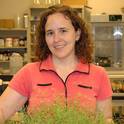
Article
IBR3, a novel peroxisomal acyl-CoA dehydrogenase-like protein required for indole-3-butyric acid response
Plant Molecular Biology
(2007)
Abstract
Indole-3-butyric acid (IBA) is an endogenous auxin that acts in Arabidopsis primarily via its conversion to the principal auxin indole-3-acetic acid (IAA). Genetic and biochemical evidence indicates that this conversion is similar to peroxisomal fatty acid β-oxidation, but the specific enzymes catalyzing IBA β-oxidation have not been identified. We identified an IBA-response mutant (ibr3) with decreased responses to the inhibitory effects of IBA on root elongation or the stimulatory effects of IBA on lateral root formation. However, ibr3 mutants respond normally to other forms of auxin, including IAA. The mutant seedlings germinate and develop normally, even in the absence of sucrose, suggesting that fatty acid β-oxidation is unaffected. Additionally, double mutants between ibr3 and acx3, which is defective in an acyl-CoA oxidase acting in fatty acid β-oxidation, have enhanced IBA resistance, consistent with a distinct role for IBR3. Positional cloning revealed that IBR3 encodes a putative acyl-CoA dehydrogenase with a consensus peroxisomal targeting signal. Based on the singular defect of this mutant in responding to IBA, we propose that IBR3 may act directly in the oxidation of IBA to IAA.
Disciplines
Publication Date
April 5, 2007
DOI
10.1007/s11103-007-9134-2
Citation Information
Bethany K. Zolman, Michelle Nyberg and Bonnie Bartel. "IBR3, a novel peroxisomal acyl-CoA dehydrogenase-like protein required for indole-3-butyric acid response" Plant Molecular Biology Vol. 64 (2007) p. 59 - 72 Available at: http://works.bepress.com/bethany-zolman/12/
